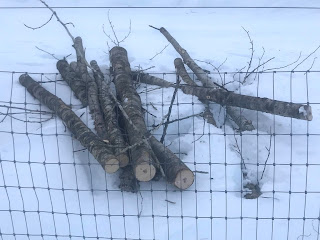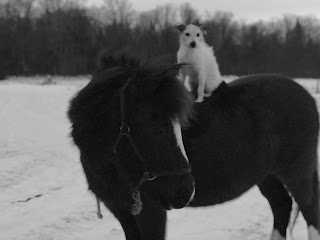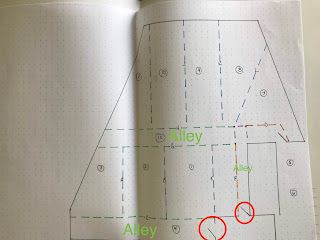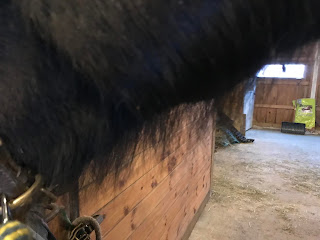As often as I encourage giving horses and dogs enrichment, I sometimes get the response of, “oh he’s not smart enough to figure that out” or “she’s too lazy to do that, she just wants to eat”. I’m not always sure if that’s an assumption people make because they think of their animals a certain way or if they have tried it unsuccessfully. In either case, my response is the same as it is for other training challenges: break it down, make it easier. And then slowly increase the challenge.
I know from experience that learning to slice things into easier steps is a skill which takes time to develop so here are some suggestions.
Enrichment items sometimes come in the form of an obvious puzzle, such as items that require an animal to “open” it before finding the treat. But even if the toy appears straightforward to you such as a kong with food sitting right inside easy for the animal to see and smell, if the animal’s experience with eating has been having their food in an open bowl or tub to eat simply, they might not be sure what to do. And if the animal has ever been punished for helping themselves to food (i.e. getting into a bag of food or treats left where they could access it), then they are going to be more skeptical about investigating further. So first:
Make it Easy:
If food is spilling out of the toy into the dish or bucket the animal usually eats from, it is going to encourage them to go for it to get the easy food that’s out, and then nose around for any that might be along the edge, which if they nudge it causes more to come out. That is where the learning begins: “hey, if I push this thing around with my nose, I can get more food!”.
 |
| kibble that falls right out of a kong is a good first toy for dogs |
 |
| carrot pieces poking out of a hay bag |
When first introducing enrichment, give it in addition to a normal meal. Even if our end goal is to feed the animal’s meal in a toy, (which I encourage), they can become frustrated if they now have to work for it all of a sudden. You can withhold a small portion of their food to put in the toy, and give them the rest in the way they are used to. What is really fun about this is seeing how many of them will slowly come to enjoy the challenge so much that they eat out of the toy before eating the easy stuff in the dish. Then you really have a happy consumer!
Make it Tasty:
 |
| the West Paw "tux" toy with Honest Kitchen that's easy to get started |
If you have a hungry hungry hippo for an animal, you might be able to use a low value food in the toy to start. But if you are working with one who is more particular about their food, or isn’t as enthusiastic about eating, try making the food in the toy more interesting: a sweet grain or treats you know your horses love; or some canned or dehydrated food mixed to a thin soup consistency (so it comes out easily!) for dogs. Again, you want to draw them in right away, experience the good taste, have it easy to access more, and be well worth any little work that is required to get the last of it. If they don’t finish it all right away, pick it up and clean it rather than leaving it for them. You want them to learn that they need to empty it or it will disappear, as well as making sure that remnants left inside don’t get moldy or stinky which could turn them off.
Make it Fun!
Dogs and horses both love interaction with people, so join in the fun at first, rather than handing out a food toy and walking away expecting them to entertain themselves. One of the most economical sources of toys is your recycling bin. You might dump a piece or two out of the toy right at your animal’s nose to get them interested, then shake the container so they hear the goodies inside before dumping a little more out. Put the container down and bump it yourself as they watch so they see the food coming out. Stay with them, helping if necessary but not interfering in their experimentation. If you just dump it all out, they won’t get to experience the process so give them a minute or two after you’ve helped a little to see if they start to work at it. If they manipulate the toy and get nothing, then step in quickly so that the consequences are rewarding, even if they didn’t quite do it hard enough themselves yet. The next time let them work at it a little more before helping out so they learn to keep trying and they will get something for their efforts.
Increase difficulty slowly!
Once your animal has figured the toy out, don’t immediately jump from easy kibble that falls out to a frozen kong or from a hay net to a bob o lot with big treats that are hard to get out. Make it just a little more challenging every day, making sure your animal continues to be successful and that you introduce new toys or trickier foods while watching to be ready to help if needed.
examples: after kibble in a kong, try peanut butter that is stickier but most dogs find really high value. Then stick some kibble in the peanut butter. Then mix some peanut butter with some yogurt, working up over time to freezing a yogurt/kibble/peanut butter mix into a kong…maybe even adding a “handle” of a bully stick or other chew.
 |
| jamming two carrots from opposite ends into this carrot ball is a bigger challenge better left to when the horse has had many successes with easier presentations |
For horses, use hay to plug the hole of a Kong Equine or plastic jug so that when they pull on the hay to eat, pellets inside (grain or hay) fall right out. Then leave the jug on the ground so they push it around to get the goodies out. For a bigger challenge, hang the jug right side up so they have to knock it around a lot to empty it (for hanging things with horses, I like to stay right there so no one gets tangled, but you could do this while you do chores and are there to keep an eye on safety).
Remember this is supposed to improve your animals' days and so if it takes some time to teach them, it's time well spent. If they are finding it too hard, it defeats the purpose.
And take the time to enjoy observing them! Sure, I do it so that I can get some free time, but I also love to see them enjoy what I offer.




























